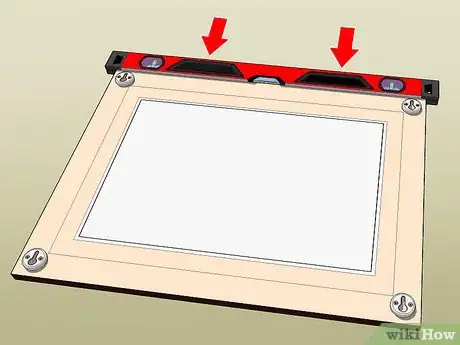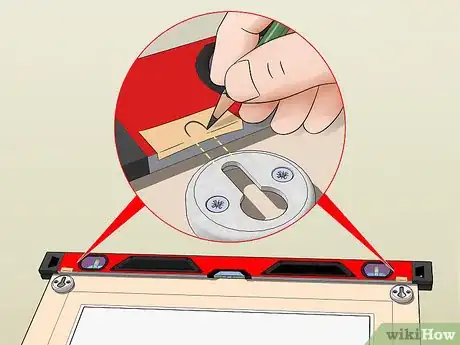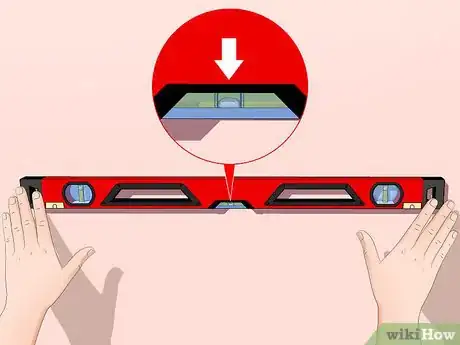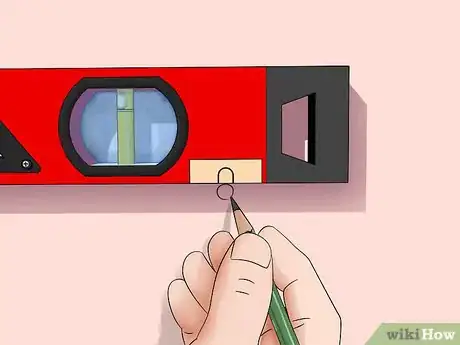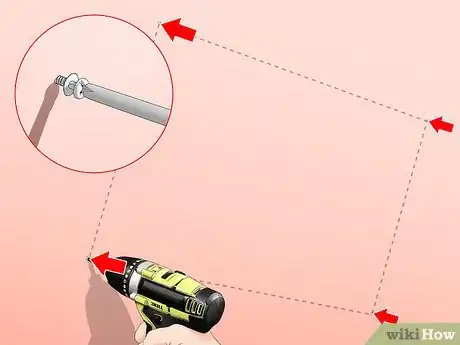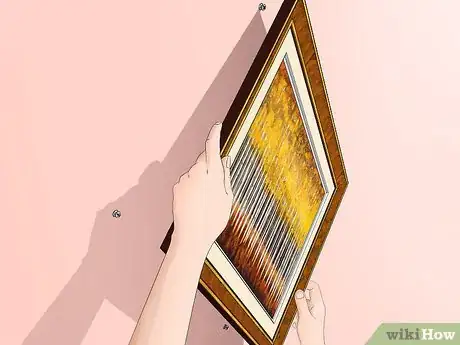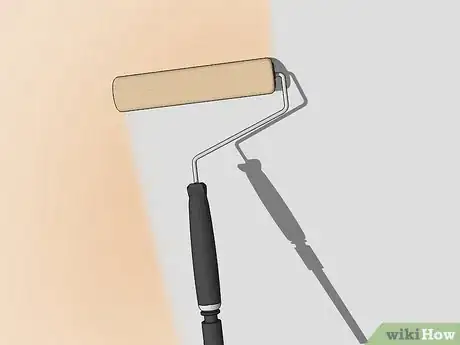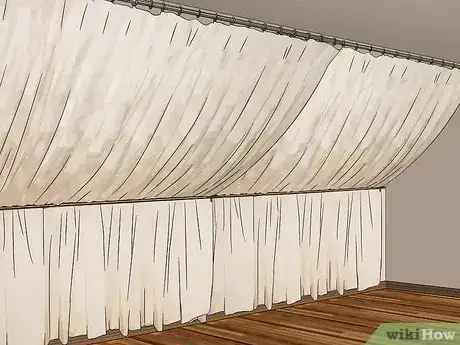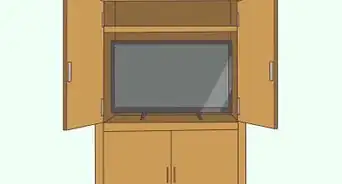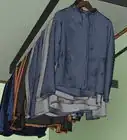This article was co-authored by Katherine Tlapa and by wikiHow staff writer, Amy Bobinger. Katherine Tlapa is an interior designer, currently working as a Design Specialist for Modsy, a design service based in San Francisco. She also runs her own DIY Home Design blog, My Eclectic Grace. She received her BFA in Interior Architecture from Ohio University in 2016.
There are 9 references cited in this article, which can be found at the bottom of the page.
This article has been viewed 61,695 times.
While slanted walls can create a cozy feel in a room, they can also be difficult to decorate. For instance, hanging pictures from a slanted wall comes with the extra challenge of having to attach all 4 corners. Luckily, with a few convenient tricks, you can hang pictures or anything else you like from a slanted wall to make your space feel like your own. The only limit is your imagination!
Steps
Hanging Pictures on Slanted Walls
-
1Attach 1 keyhole fastener to each corner of the picture with the provided screws. When you buy the fastener, it should come with a smaller screw and a larger mounting screw. Use a screwdriver or a cordless drill to attach the fastener to the frame using the smaller screw.
- Keyhole fasteners have a small slot with a wider opening that allows you to slide them over the mounting screws. The fastener should be placed so the wide opening is at the bottom and the narrow slot is at the top.[1]
- Since you’ll need to attach the picture at all 4 corners to keep it flush to your slanted wall, being able to slide the fasteners into place will make the process much easier.
- These fasteners are often used for hanging mirror frames and can be found at any home improvement store.
- The weight load of the 4 fasteners should meet or exceed the weight of the picture. This information should be located on the packaging for the fasteners Also, make sure you choose a sturdy picture frame that won't break or splinter from being slanted.
-
2Lay the frame face-down, then place a carpenter's level flush against the top. A carpenter’s level has a bubble that will tell you if your picture is hanging straight, but it can also be helpful when you’re marking the location for your screws. After you’ve attached the fasteners, lay the frame face-down on a flat surface, then rest your level flush against the top of the frame.
- At this point, it doesn’t matter if the bubble is centered on the level.
Advertisement -
3Mark the fasteners on the level with a piece of masking tape. You don’t need much tape for this since you're just sticking the tape onto the level to mark the horizontal distance between the top 2 fasteners. A strip of masking tape that's about 1–2 in (2.5–5.1 cm) should be sufficient. Use one piece of tape for each of the top 2 fasteners.[2]
- It’s okay if the masking tape isn’t perfectly centered, but it should be wide enough to cover the entire keyhole slot in the bracket.
- Masking tape is easy to tear and can easily be marked with a pencil, which is why it's ideal for this project. You can buy masking tape anywhere that office supplies are sold.
-
4Draw the location of the fastener onto the masking tape with a pencil. Once you've placed the masking tape onto the level, use your pencil to draw a line to mark the exact location of the fastener. Make sure the mark that you draw is the same width as the keyhole slot. When you hold the level up to the wall, the pencil marks will show you exactly where to place your mounting screws.
- You can use a marker or a pen if you want, but a sharp pencil will give you the most precise results.[3]
-
5Place the level where you want the picture to hang. Once the level is flush against the wall, look at the bubble in the center tube. If the bubble is perfectly centered on the line in the tube, the level is straight. If the bubble isn’t centered, tilt the level until it is.[4]
- For the most stability, anchor the frame to one of the beams behind the wall. To do this, use a stud-finder to locate the beams, and use that to determine where you want to hang the picture.
-
6Draw marks on the wall where the top fasteners will go. Get the level perfectly even, then use your pencil to draw 2 marks that match the ones on the masking tape. Be sure to mark the width of the fasteners, since this will help you get your mounting screws perfectly centered.[5]
- If the mounting screws aren't in exactly the right place, you may not be able to secure the frame, so take the time to verify that your marks are correct.
-
7Measure the distance between the top and bottom fasteners on the frame. The easiest way to find the location for your bottom set of mounting screws is to measure the distance on the frame, then find that distance below the marks you made on the wall. Use a tape measure to get the exact distance between the keyhole cut-outs in the fastener, then write down that measurement.[6]
- Your measurement should be taken from the same place on each fastener. For instance, if you measure from the very top of one hole, be sure to measure down to the very top of the second hole as well.
- If your fasteners are installed evenly, you should only need to take one measurement. However, it never hurts to double-check by measuring both sides.
-
8Mark the height of the bottom screws on the wall with your pencil. Once you've measured the frame, go to the wall and use a tape measure and your level to create a vertical line straight down from the top marks you drew. Measure the distance for the fasteners and mark that spot on each side. These will be the locations for your bottom set of mounting screws.[7]
- For example, if the distance between the brackets is 10 in (25 cm), you would use your level to mark a spot exactly 10 in (25 cm) down the wall from the first marks you drew.
-
9Install the 4 mounting screws into the locations you marked on the wall. Use a cordless drill to attach the mounting screw into the wall. Depending on what type of wall you have, you may need to use anchors to secure the screws, especially if you aren't attaching the frame to the beams behind the wall.[8]
- For instance, if you’ll be installing your picture in drywall, you’ll either need to screw it into the studs or use drywall anchors to support the weight of the frame.
- You’ll also need to use anchors if you’re trying to hang a picture on cement or brick.
-
10Hang the fasteners on the mounting screws. Hold the frame up flush against the wall so the fasteners are lined up just above the mounting screws, then slide the frame down slowly until you feel the mounting screws slide into the keyholes.[9]
- It can be hard to get all 4 of the keyholes lines up perfectly, so this might take a few tries.
- If the picture is heavy, it’s probably a good idea to ask a friend to help you hold the picture up.
Adding Color to the Wall
-
1Paint the slanted wall if you want a striking accent. Choose a light color to brighten up the space, or opt for a bright, bold hue for a fun effect. When you're painting, cut in around the ceiling, doors, and walls with an angled 2.5 in (6.4 cm) brush, then use a paint roller for the rest. Let the paint dry completely between coats.[10]
- Painting the sloped wall a different color from the rest of the room can create a fun, eye-catching accent, especially if the wall has a gentle slope. If the wall is steeply sloped, opt for a light color or one that matches the rest of the room.
- If you have 2 walls with a steep slope, painting them the same color as the rest of the room can help keep the space from feeling claustrophobic.
- Since sloped walls can already make a room feel smaller, it's not usually a good idea to paint them a darker color. This can make the room feel cramped and cave-like. If that's the look you're going for, though, have fun with it!
- If your slanted wall is behind your bed or another piece of furniture, you might paint a mural on the wall. For example, stars and clouds are an interesting backdrop for a bed.
-
2Hang wallpaper on the sloped wall to create a patterned accent wall. While many people think of wallpaper as being dated, modern wallpaper can be very elegant, playful, or chic, depending on the design you choose. The application method will vary depending on the type of wallpaper you choose, but in most cases, you will apply wallpaper adhesive to the back of the paper, then carefully smooth the paper against the wall.[11]
- For a kids' room, choose a brightly-colored wallpaper with a fun design like clouds or robots.
- Create a more classic, subtle look, select wallpaper with tone-on-tone stripes that are similar to the existing color in the room.
- Since many wallpapers have a sticky back, it's fairly simple to apply it yourself. However, it's best to ask a friend to help you put up your wallpaper if your wall is slanted.
-
3Use vinyl wall decals for a fun, temporary decoration. If you want to add your own touch to the room but you aren't sure you want to commit to paint or wallpaper, choose vinyl wall decals to create a look that's all your own. Just wipe down the wall with a damp cloth and let it dry, then peel the decal off of its backing and smooth it onto the wall. If there are any bubbles, press them out with a thin, flat object, like a credit card.[12]
- You can order vinyl wall decals from a number of places online. To find a trustworthy vendor, read customer reviews to see if previous buyers have been satisfied with the quality of the product.
- Vinyl wall decals are available in everything from abstract designs to elaborate scenes, so browse around and find something that matches your personal style!
- For a child's room, kitchen, or office, you might choose a vinyl chalkboard, which you can write on.
-
4Hang fabric from the slanted wall to take advantage of the draped effect. Fabric is a unique way to cover a wall, and a slanted wall is a perfect canvas. Gravity will pull the material down in the middle, creating a gentle drape that softens the harsh lines in the room. You can use push-pins, curtain rods, or velcro to attach the fabric at all 4 corners. The final effect will depend on how you hang the material as well as the weight of the fabric.[13]
- For instance, you might get a soft tent-like effect from a heavier material like jersey, whereas a lightweight, sheer fabric would create more of a romantic sweep.
- If you’re hanging a lightweight fabric or you’re covering a small wall, you could place push-pins in each corner or around the top and bottom borders of the material.
- For heavier materials or larger walls, install drapery rods across the top and bottom of the sloped wall and sew pockets into the fabric.
- If you don’t want to put holes in the wall, try hanging the fabric with strips of velcro. Peel off the adhesive backing from a strip of velcro and press it to one corner of the fabric, then stick the other side of the velcro to the wall. Repeat for all 4 corners, and add additional strips along the top and bottom edges if you need to.
- To create a canopy effect, hang the fabric from the top of the slant down to the floor.
Choosing the Final Touches
-
1Hang a string of lights to make the space feel cozier. An attic room can sometimes feel a little isolated, but if you add a string of warm lights, you create an intimate, welcoming space instead. Depending on the effect you want to create, you could use anything from a delicate string of fairy lights to more industrial Edison bulbs. You can hang the lights by stringing them across nails, thumbtacks, or even clear adhesive-backed hooks, which are a great option if you don't want to put holes in the walls.[14]
- String lights create a calm, relaxing effect. They're a great option for providing dim lighting while you watch a movie, listen to music, or relax in the evening.
- If you want to hang the lights in an area without an electrical outlet, try a battery-powered string of lights instead.
-
2Hang a dramatic light fixture to draw your eyes upward. If you prefer a more classic look, find an eye-catching light fixture, and hang it from the center of the room. Just think about the proportion of the light to the room, as well as the width of the fixture and the slope of the walls.[15]
- A dropped pendant lamp or a hanging chandelier can add an elegant touch to a room with sloped walls.
- If you're decorating a room with 2 sloped walls that meet in a steep point, a wide lamp fixture might not fit. If the steep is less severe, but the room has a low ceiling, a light that hangs down low might make the room feel cramped.
-
3Opt for low-lying bookshelves and storage to make the most of the room. Aside from the logistical issues, installing shelving on a sloped wall can make the room feel claustrophobic. Instead, opt for bookcases, ottomans, and other furniture that sits as low to the ground as possible.[16]
- This will make the room feel loftier, rather than closed-in.
- Try to keep the furnishings in the room minimal so the space doesn't get overwhelmed.[17]
Things You'll Need
Hanging Pictures
- 4 keyhole fasteners
- 8 screws (4 standard, 4 mounting screws)
- Screwdriver or cordless drill
- Carpenter's level
- Masking tape
- Tape measure
- Anchors (optional)
- Sharp pencil
Adding Color to the Walls
- Paint (optional)
- Paintbrush (optional)
- Roller (optional)
- Wallpaper (optional)
- Vinyl wall decals (optional)
- Tapestry (optional)
- Push-pins, staples, nails, etc (optional)
Choosing the Final Touches
- Fairy lights (optional)
- Light fixture (optional)
- Low-lying furniture
References
- ↑ https://diy.stackexchange.com/questions/86692/hanging-pictures-on-a-sloping-plasterboard-wall
- ↑ https://www.woodmagazine.com/woodworking-tips/techniques/beginner/foolproof-hanging-with-keyhole-slots
- ↑ https://www.woodmagazine.com/woodworking-tips/techniques/beginner/foolproof-hanging-with-keyhole-slots
- ↑ https://www.woodmagazine.com/woodworking-tips/techniques/beginner/foolproof-hanging-with-keyhole-slots
- ↑ https://www.woodmagazine.com/woodworking-tips/techniques/beginner/foolproof-hanging-with-keyhole-slots
- ↑ https://www.woodmagazine.com/woodworking-tips/techniques/beginner/foolproof-hanging-with-keyhole-slots
- ↑ https://www.woodmagazine.com/woodworking-tips/techniques/beginner/foolproof-hanging-with-keyhole-slots
- ↑ https://www.woodmagazine.com/woodworking-tips/techniques/beginner/foolproof-hanging-with-keyhole-slots
- ↑ https://www.woodmagazine.com/woodworking-tips/techniques/beginner/foolproof-hanging-with-keyhole-slots
- ↑ https://www.familyhandyman.com/painting/techniques/the-best-tips-for-cutting-in-paint/view-all/
- ↑ https://www.thisoldhouse.com/how-to/how-to-hang-wallpaper
- ↑ http://www.apartmenttherapy.com/getting-it-right-the-first-time-how-to-layout-and-apply-stickon-wall-decals-apartment-therapy-tutorial-188592
- ↑ https://www.architecturaldigest.com/story/how-to-hang-a-tapestry
- ↑ https://www.apartmenttherapy.com/string-lights-tips-258617
- ↑ https://www.apartmenttherapy.com/string-lights-tips-258617
- ↑ https://www.decoist.com/2014-07-08/slanted-ceilings-design-ideas/
- ↑ http://www.architectureartdesigns.com/26-brilliant-bedroom-designs-ideas-with-sloped-ceiling/

